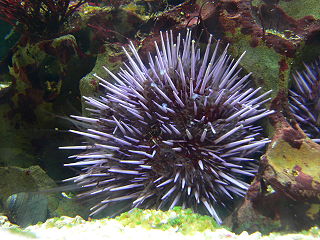
Coelopleurus is an extant genus of echinoids with fossil records dating back to the Eocene, with remains found in Europe and North America.

Strongylocentrotus is a genus of sea urchins in the family Strongylocentrotidae containing several species.
Acanthocidaris hastingeria is a species of sea urchin of the family Cidaridae. Their armour is covered with spines. It came from the genus Acanthocidaris and lives in the sea. Acanthocidaris hastingeria was first scientifically described in 1907 by Alexander Emanuel Agassiz & Hubert Lyman Clark.
Aceste ovata is a species of sea urchin of the family Schizasteridae. Their armour is covered with spines. It came from the genus Aceste and lives in the sea. Aceste ovata was first scientifically described in 1907 by Alexander Emanuel Agassiz & Hubert Lyman Clark.
Anametalia grandis is a species of sea urchin of the family Brissidae. Their armour is covered with spines. It is placed in the genus Anametalia and lives in the sea. Anametalia grandis was first scientifically described in 1950 by Ole Mortensen.
Anametalia regularis is a species of sea urchin of the family Brissidae. Their armour is covered with spines. It is placed in the genus Anametalia and lives in the sea. Anametalia regularis was first scientifically described in 1925 by Hubert Clark.
Aporocidaris fragilis is a species of sea urchin of the family Ctenocidaridae. It is well-armoured with spines. It is placed in the genus Aporocidaris and lives in the sea. Aporocidaris fragilis was first scientifically described in 1907 by Alexander Emanuel Agassiz & Hubert Lyman Clark.
Araeosoma eurypatum is a species of sea urchin of the family Echinothuriidae. Their armour is covered with spines. It is placed in the genus Araeosoma and lives in the sea. Araeosoma eurypatum was first scientifically described in 1909 by Alexander Agassiz and Hubert Clark.
Araeosoma leptaleum is a species of sea urchin of the family Echinothuriidae. Their armour is covered with spines. It is placed in the genus Araeosoma and lives in the sea. Araeosoma leptaleum was first scientifically described in 1909 by Alexander Emanuel Agassiz & Hubert Lyman Clark.

Echinometra is a genus of sea urchins in the family Echinometridae.
Caenopedina pulchella is a species of sea urchins of the family Pedinidae. Their armour is covered with spines. Caenopedina pulchella was first scientifically described in 1907 by Alexander Emanuel Agassiz and Hubert Lyman Clark.
Centrostephanus asteriscus is a species of sea urchins of the Family Diadematidae. Their armour is covered with spines. Centrostephanus asteriscus was first scientifically described in 1907 by Alexander Emanuel Agassiz & Hubert Lyman Clark.
Chaetodiadema pallidum is a species of sea urchins of the Family Diadematidae. Their armour is covered with spines. Chaetodiadema pallidum was first scientifically described in 1907 by Alexander Emanuel Agassiz and Hubert Lyman Clark.

Chaetodiadema is a genus of sea urchins of the Family Diadematidae. Their armour is covered with spines.
Chondrocidaris is a genus of sea urchins of the family Cidaridae described in 1863 by Alexander Agassiz. There are two living species and several fossil species dating as far back as the Miocene.

Araeosoma is a genus of deep-sea sea urchins in the family Echinothuriidae.
Aporocidaris is a genus of sea urchins in the family Ctenocidaridae. Several species are found in deep water in circum-Antarctic locations.

Clypeasteridae is a family of sea urchins in the order Clypeasteroida. This family was first scientifically described in 1835 by the Swiss-American biologist Louis Agassiz.







